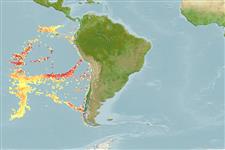Chiridota hydrothermica Smirnov & Gebruk, 2000
| Native range | All suitable habitat | Point map | Year 2050 |

|
| This map was computer-generated and has not yet been reviewed. |
| Chiridota hydrothermica AquaMaps Data sources: GBIF OBIS |
Google image |
No photo available for this species.
Classification / Names Populärnamn | synonymer | CoL | ITIS | WoRMS
Holothuroidea | Apodida | Chiridotidae
Environment: milieu / climate zone / djupintervall / distribution range Ekologi
; djupintervall 2000 - 2830 m (Ref. 474). Tropical
Distribution Länder | FAO områden | Ekosystem | Förekomster | Utplanteringar
Central Pacific: Manus and North Fiji basins and East-Pacific Ridge.
Length at first maturity / Size / Weight / Age
Könsmognad: Lm ? range ? - ? cm Max length : 26.0 cm TL hane/ej könsbestämd; (Ref. 474); common length : 0.0 cm hane/ej könsbestämd; (Ref. )
Life cycle and mating behavior Könsmognad | Reproduktion | Lek | Eggs | Fecundity | Larvae
Main reference
referenser | Koordinator | Medarbetare
Smirnov, A.V., A.V. Gebruk, S.V. Galkin and T. Shank 2000 New species of holothurian (Echinodermata: Holothuroidea) from hydrothermal vent habitats. Journal of the Marine Biological Association (UK) 80:321-328. (Ref. 474)
IUCN Red List Status
(Ref. 130435: Version 2025-1)
CITES status (Ref. 108899)
CMS (Ref. 116361)
Threat to humans
Human uses
| FishSource |
Verktyg
Ytterligare information
Födosammansättning
Födointag
Predatorer
Max. ages / sizes
Length-weight rel.
Length-length rel.
Length-frequencies
Mass conversion
Abundans
Internet-källor
BHL | BOLD Systems | CISTI | DiscoverLife | FAO(Publication : search) | Fishipedia | GenBank (genome, nucleotide) | GloBI | Gomexsi | Google Books | Google Scholar | Google | PubMed | Tree of Life | Wikipedia (Go, sök) | Zoological Record


